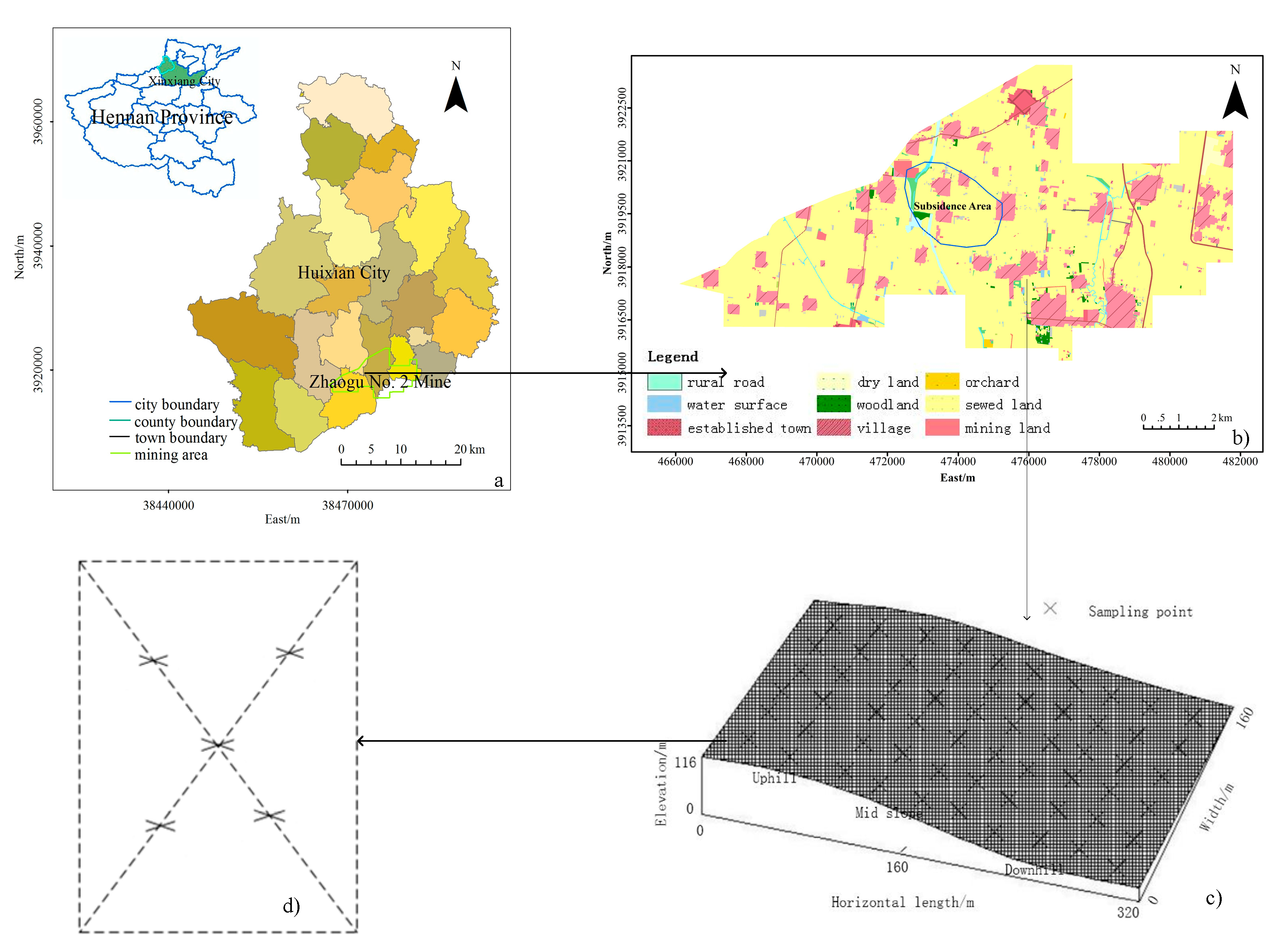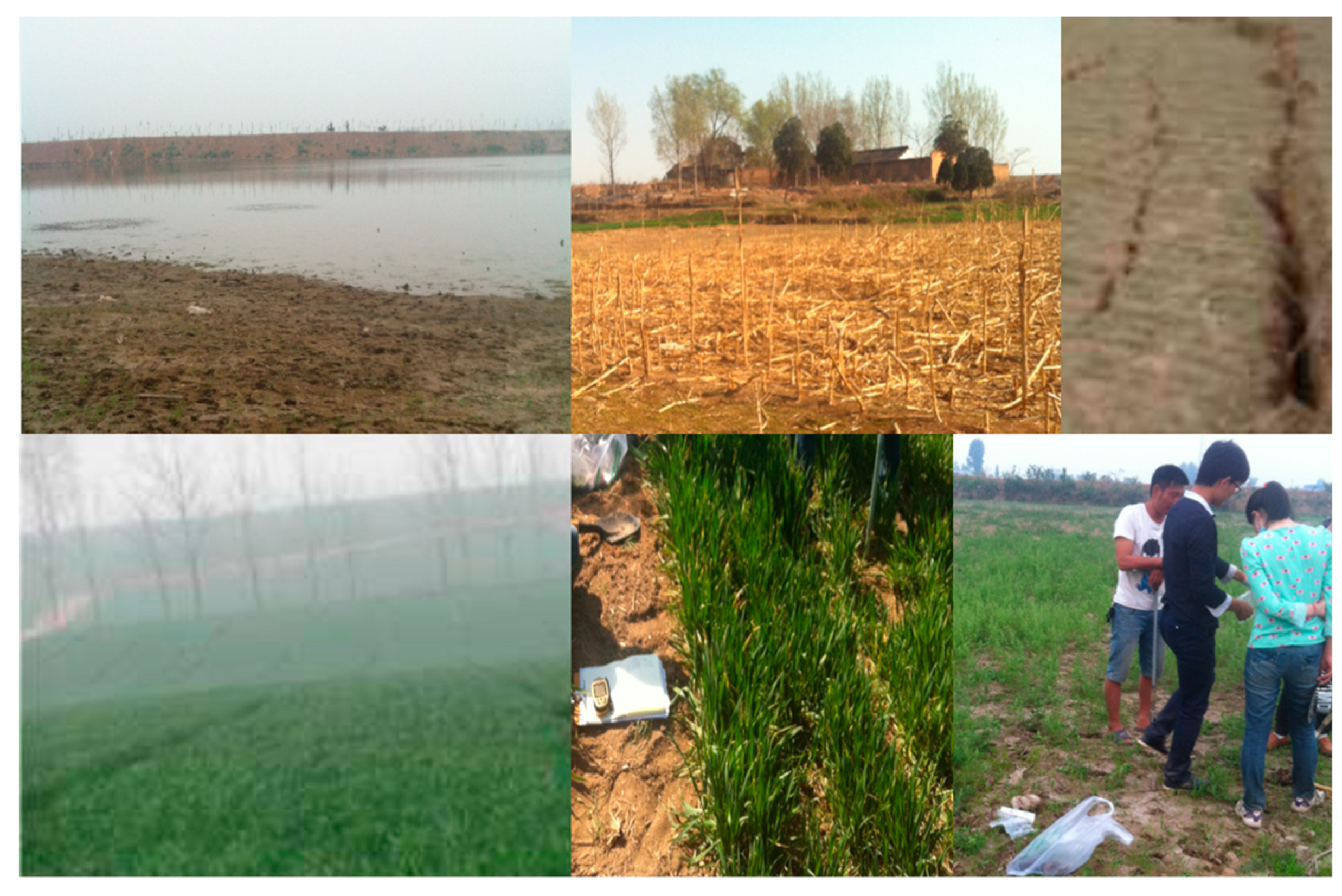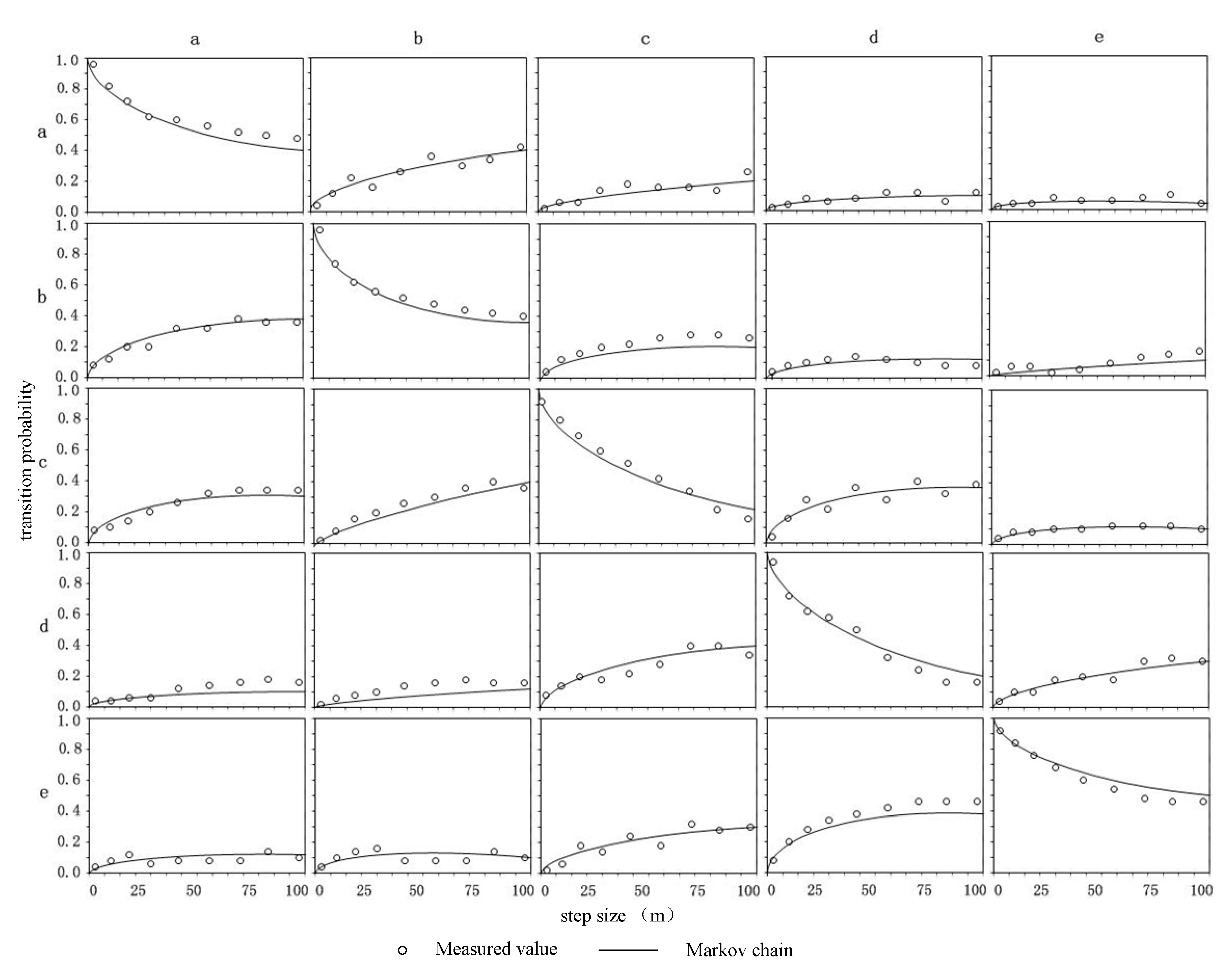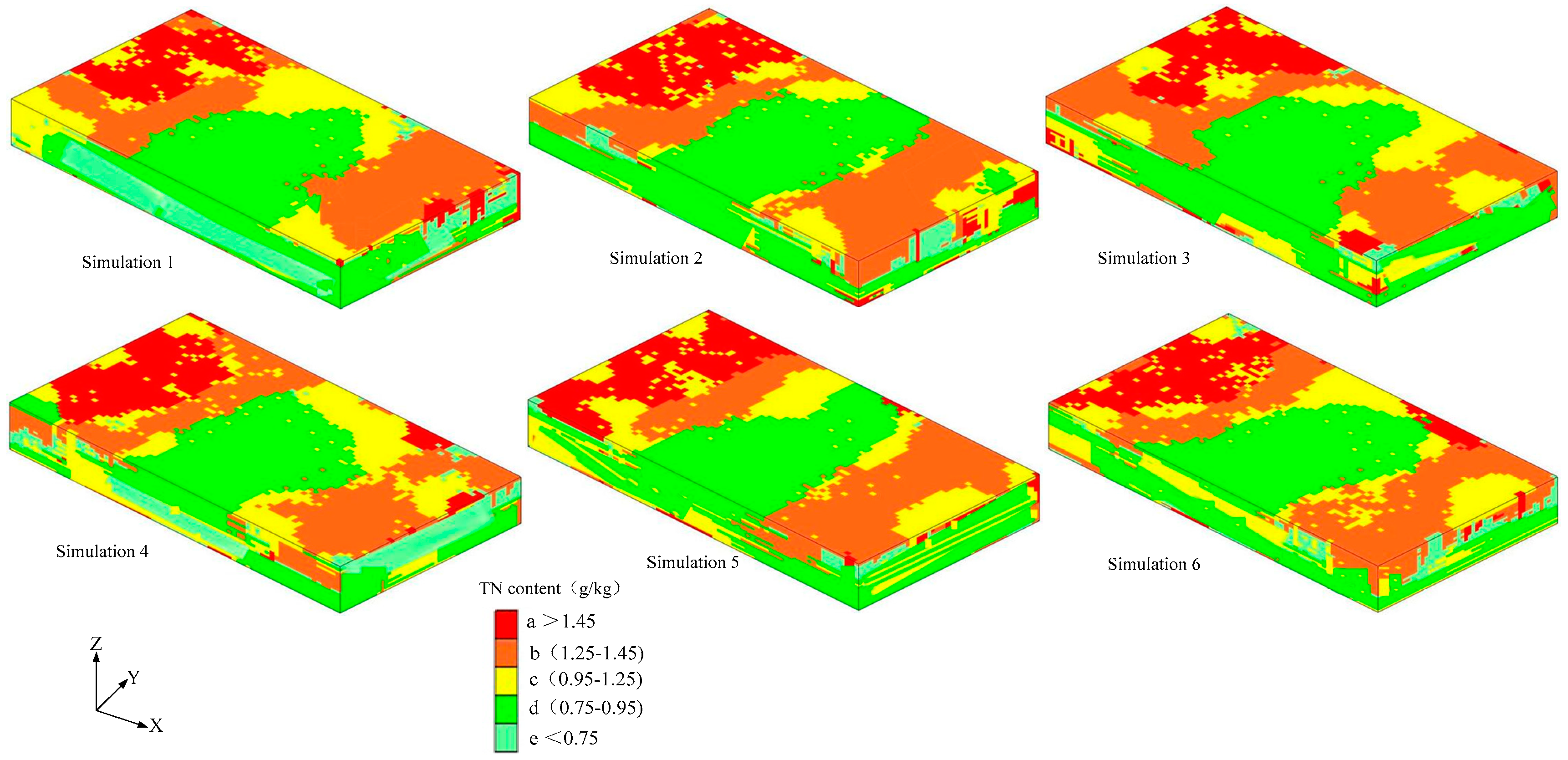1. Introduction
China is a large energy consumer. Abundant natural resources are very important to China’s economic development, especially coal and arable land [
1]. Coal energy accounts for approximately 75% of the total primary energy production in China. More than 95% of coal is mined underground in China [
2]. However, underground coal mining produces cracks and land subsidence [
3,
4]. Subsidence refers to the surface movement or local sudden depression caused by the movement of the overlying strata, ground subsidence or cracks caused by underground coal mining activities [
2]. Underground coal mining has destroyed many land resources, most of which are farmland. Additionally, population growth and economic growth have led to a dramatic increase in food demand worldwide, and underground coal mining can also negatively impact vegetation and soil quality and alter soil physicochemical properties, putting food security at risk [
5,
6]. Coal mining subsidence leads to the decrease of soil nutrient content in the arable land in the mining area; therefore, the quality of soil in arable land in mining areas is degraded, affecting the growth of crops and reducing grain yield [
7]. Coal mining subsidence will also accelerate soil erosion and underground leakage, leading to a serious loss of total nitrogen (TN) in the soil, making the land more barren and affecting the growth of vegetation in a mining area [
8,
9]. Approximately 200 km
2 of agricultural areas in China have been affected by underground coal mining, resulting in soil erosion and degradation of arable land [
10]. In addition, the subsidence area of mining areas increases by approximately 20,000 hectares every year [
11,
12]. Additionally, the eastern plain of China is characterised by long-term, multifrequency and high-intensity mining. The underground water level of the mining area is high, and coal mining subsidence is likely to form a large subsidence water area, resulting in serious damage to cultivated land and a reduction in grain production [
13,
14,
15]. Therefore, it is necessary to improve the soil quality of the mining area and promote the sustainable development of the ecological environment of the cultivated land [
16,
17,
18].
Soil nutrients are widely used to study and analyze ecosystem degradation [
19]. External environment can influence spatial variability of soil nutrients [
20,
21]. Soil nutrients are important for food security and sustainable development [
22,
23]. Soil TN is an important indicator used to measure soil quality. Soil TN provides plants with sufficient nitrogen by enhancing carbon absorption and promoting crop photosynthesis, thereby promoting plant growth. In addition, fertilization management is also the key to improving the soil total nitrogen content [
24]. In addition, soil TN is an important nutrient element index. The quantity and quality of soil TN directly affect soil characteristics and can reflect the level of soil fertility [
23,
25,
26]. Therefore, an in-depth understanding of the three-dimensional spatial variation characteristics of soil total nitrogen will help to improve the sustainable development of mining land and provide valuable guidance and a basis for land consolidation and precision agriculture in mining areas [
27,
28,
29]. Soil is a continuous three-dimensional entity with spatial variation in both horizontal and vertical directions. By studying soil characteristics through three-dimensional spatial distribution, a more comprehensive understanding of soil quality can be obtained [
30,
31]. At present, research on the spatial variation in soil properties mainly focuses on the two-dimensional horizontal direction, and the properties of different soil layers are discontinuous in the vertical direction. If the influence of the vertical direction is ignored, the crop availability of nutrient elements in different soil layers will be affected. Markov chain theory has been introduced into the field of spatial distribution in recent years. This method uses transition probability to describe the spatial variation of elements, which is descriptive, easy to understand, and well supported by random theory [
32,
33,
34].
At present, domestic and foreign scholars mainly study the effects of soil erosion, land use change and other factors on soil total nitrogen, in grassland, forestland, wetland, and cultivated land areas, thus providing a good foundation for regional agricultural soil. The evaluation of total nitrogen provides a theoretical basis [
35]. Markov geostatistical methods are widely used in the analysis of soil salinity, soil saturated hydraulic conductivity, heavy metal contents, water content, soil texture, and the soil clay content [
36]. For example, Zhang et al. (2022) studied the spatial driving force of grassland degradation on nutrients such as total nitrogen in the topsoil of an alpine meadow in Sanjiangyuan National Park. The research results can provide theoretical support for the management and restoration of soil nutrient function [
37]. Tian et al. (2022) studied the effect of different land use types on soil total nitrogen. The study found that the different land use types had a significant impact on nitrogen distribution [
38]. Turgay Dindaroglu et al. (2021) investigated soil organic carbon and total nitrogen contents in a semiarid karst ecosystem. The analysis showed that soil total nitrogen, organic carbon, pH and land use were the most effective variables that affected the distinction between depressions and nondepressions in karst ecosystems. Among them, forest and pasture soil total nitrogen and organic carbon had the highest values, while farmland had the lowest values [
39]. Yongqiang Zhang et al. (2021) examined different vegetation types and altitudes of the Yunnan Mountains and analysis of soil organic carbon and total nitrogen content. The results showed that vegetation type, altitude and pH were the main factors [
40]. Jinlin Li et al. (2018) used the Markov chain and kriging interpolation methods to study the soil texture in the mountainous area of Northwest China. The results showed that the kriging interpolation method has a certain smoothing effect, which reduces the accuracy of the simulation; the Markov stochastic simulation method realizes the stochastic simulation of spatial variables, which is more suitable for the study of soil texture in mountainous areas [
41]. Badreddine Dahmoune et al. (2019) used the Markov chain model to study the earthquake disaster in northwestern Algeria; and used the transition probability matrix to simulate the probability of earthquake occurrence in the next few decades [
42]. Afsaneh Ghaffari Rad et al. (2021) used the Markov chain method to select drill bits for different sedimentary formations and proposed appropriate drill bits for different sedimentary formations [
43]. However, in summary, there are few studies of soil TN in coal mining subsidence areas, especially three-dimensional spatial simulation research, which is not conducive to the accurate evaluation of soil total nitrogen in mining areas and ecological restoration research.
Therefore, this study aims to (1) construct the three-dimensional spatial distribution of soil TN by using the Markov stochastic simulation method, (2) analyse the differences in the spatial distribution of soil TN at different locations and (3) explore the influence of the spatial distribution of the main influential factors of total nitrogen.
5. Conclusions
This paper takes the Zhaogu mining area, Huixian city, Henan Province, as the research object and studies the spatial distribution characteristics of soil TN at different soil depths (0–20 cm, 20–40 cm, 40–60 cm). The three-dimensional continuous Markov chain model of the TN content realizes the three-dimensional spatial simulation of the TN content. Combined with natural factors and human factors, soil total nitrogen content is analyzed, including sunshine time, soil texture, coal mining subsidence, cracks, water content, etc. The results show that (1) the soil TN content in the coal mining subsidence area has obvious spatial distribution differences at different soil layer depths, and soil TN has the largest spatial variation at soil depths 0–20 cm; with increasing soil depth, the spatial variation gradually decreases, and the spatial variation in TN in the 40–60 cm soil layer tends to stabilize. (2) The vertical and horizontal (X-Y) transfer probability models can directly reflect the spatial distribution characteristics of soil TN and describe the spatial distribution variability of soil TN. In this paper, the TN content less than 0.95 g/kg accounted for the largest proportion, approximately 70%, mainly distributed beneath the 0–20 cm soil layer. (3) Soil texture had a certain effect on the soil TN content. Coal mining subsidence cracks accelerated soil erosion, reduced the soil fertility retention capacity, and had a strong impact on the soil TN content. External management also had a certain effect on soil TN. The amount of fertilizer, crop planting and management methods, as well as irrigation methods have a certain effect on the TN content of soil. This study suggested that coal mining, soil texture, and artificial management methods are all crucial to soil TN storage and should be considered. At the same time, the spatial distribution of soil TN was affected by sunshine duration, crop and fertilization. In addition, results such as these can provide a reference for ecological restoration and sustainable development research in ecologically degraded areas.











